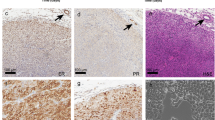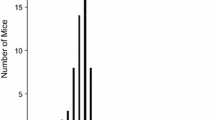Summary
A new spontaneously arisen murine breast tumor, designated JC, has been established in immunocompetent BALB/c mice. Upon reestablishment of tumor in vitro and in vivo, the epithelial murine tumor cells retained their original papillary adenocarcinoma morphology. Various immunotherapy protocols have been performed in previously implanted and progressively growing JC tumor in syngeneic hosts with a murine monoclonal antibody (McAb), F36/22 (IgG3). Affinity of McAb binding to JC tumor cells was determined to be 6.1×107 L/M. Quantitatively 1.2×105 molecules of McAb bound to a JC tumor cell. Immunotherapeutic effectiveness in vivo on a tumor mass after its establishment is a major feature of this experimental tumor model. When four sequential administration of McAb, i.p., at a dose of 400 μg 4 days apart were used, McAb-treated animals showed statistically significant tumor regression and longer survival than those of control animals treated with an irrelevant McAb of the same isotype. Two temporal phases of tumoricidal activity were observed as measured by tumor volume reduction. The first phase of tumoricidal response (tumor regression) was detected within days upon the first administration of McAb. A distinct second phase followed within 3–5 weeks after the last McAb administration, which resulted in tumor necrosis even in large tumors. Histological examinations revealed heavy infiltration of inflammatory cells at the beginning of the second phase. Similar tumor regression was also obtained from animals treated with a single dose (400 μg) of McAb followed by injections of McAb with complete and incomplete adjuvant, respectively. These results demonstrate that this syngeneic murine mammary tumor can serve as a potential preclinical model for investigation of parameters and mechanisms associated with McAb immunotherapy.
Similar content being viewed by others
References
Adams DOT, Hall T, Steplewski Z, Koprowski H (1984) Tumors undergoing rejection induced by monoclonal antibodies of the IgG2a isotype contain increased numbers of macrophages activated for a distinctive form of antibody-dependent cytolysis. Proc Natl Acad Sci USA 81:3506–3510
Capone PM, Papsidero LD, Croghan GA, Chu TM (1983) Experimental tumoricidal effects of monoclonal antibody against solid breast tumors. Proc Natl Acad Sci USA 80:7328–7332
Capone PM, Papsidero LD, Chu TM (1984) Relationship between antigen density and immunotherapeutic response elicited by monoclonal antibodies against solid tumors. J Natl Cancer Inst 72:673–677
Groghan GA, Papsidero LD, Valenzuela LA, Nemoto T, Penetrante R, Chu, TM (1983) Tissue distribution of an epithelial and tumor-associated determinant recognized by monoclonal antibody F36/22. Cancer Res 43:4980–4998
Croghan GA, Wingate MB, Gamarra M, Johnson E, Chu TM, Allen H, Valenzuela L, Tsukada Y, Papsidero LD (1984) Reactivity of monoclonal antibody F36/22 with human ovarian adenocarcinomas. Cancer Res 44:1954–1962
Diamond B, Yelton DE (1981) A new Fc receptor on mouse macrophages binding IgG3. J Exp Med 153:514–519
Horoszewicz JS, Leong SS, Kawinski E, Karr JP, Rosenthal H, Chu TM, Mirand EA, Murphy GP (1983) LNCaP model of human prostatic carcinoma. Cancer Res 43:1809–1818
Kennel SJ, Lankford T, Flynn KM (1983) Therapy of a murine sarcoma using syngeneic monoclonal antibody. Cancer Res 43:2843–2848
Kennel SJ, Lankford T, Flynn KM, Winegar R (1985) Factors affecting passive monoclonal antibody therapy of Moloney sarcoma in BALB/c mice. Cancer Res 45:3782–3789
Koprowski H, Herlyn D, Lutech M, DeFriestas E, Sears, HF (1984) Human anti-idiotypic antibody in cancer patient. Is the modulation of the immune response beneficial to the patient? Proc Natl Acad Sci USA 81:216–219
Majarion WE, Daly TM, Weindanz WP, Long CA (1984) Passive immunization against malaria with an IgG3 monoclonal antibody. J Immunol 132:3134–3137
Papsidero LD, Croghan GA, O'Connell MJ, Valenzuela LA, Nemoto T, Chu TM (1983) Monoclonal antibodies (F36/22 and M7/105) to human breast carcinoma. Cancer Res 43:1741–1747
Papsidero LD, Croghan GA, Johnson EA, Chu, TM (1984) Immunoaffinity isolation of ductal carcinoma antigen using monoclonal antibody F36/22. Mol Immunol 21:955–960
Papsidero LD, Nemoto T, and Chu TM (1984) Expression of ductal carcinoma antigen in breast cancer sera as defined using monoclonal antibody F36/22. Cancer Res 44:4653–4657
Seman G, Dmochowski L (1975) Ultrastructural characteristic of human cells in vitro. In: Fogh J (ed) Human tumor cells in vitro. Plenum Press, New York
Author information
Authors and Affiliations
Rights and permissions
About this article
Cite this article
Capone, P.M., Kadohama, N. & Chu, T.M. Immunotherapy in a spontaneously developed murine mammary carcinoma with syngeneic monoclonal antibody. Cancer Immunol Immunother 25, 93–99 (1987). https://doi.org/10.1007/BF00199947
Received:
Accepted:
Issue Date:
DOI: https://doi.org/10.1007/BF00199947




